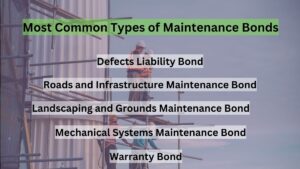What Is a Maintenance Bond?
What Is the Purpose of a Maintenance Bond?
How Does a Maintenance Bond Work?
Most Common Types of Maintenance Bonds
Defects Liability Bond
This type of maintenance bond is aimed at covering defects and faults in construction projects. It ensures that the contractor will rectify any identified issues during the specified maintenance period.
Roads and Infrastructure Maintenance Bond
Commonly used in public infrastructure projects, this bond guarantees that the contractor will maintain roads, bridges, utilities, or other infrastructure in good working condition for a specified period after completion.
Landscaping and Grounds Maintenance Bond
This type of bond is applicable to projects that involve landscaping, gardens, parks, or other outdoor areas. It ensures that the contractor will maintain the specified landscaping features and grounds in a satisfactory condition for a defined period.
Mechanical Systems Maintenance Bond
Often used in projects involving mechanical systems such as HVAC (heating, ventilation, and air conditioning), plumbing, or electrical systems, this bond guarantees that the contractor will rectify any issues or malfunctions during the maintenance period.
Warranty Bond
While not strictly a maintenance bond, a warranty bond is closely related. It provides coverage for the warranty obligations of a contractor or manufacturer, ensuring that they will fulfill their warranty commitments, such as replacing defective equipment or providing repairs within the specified warranty period.
Benefits of a Maintenance Bond
A maintenance bond, also known as a maintenance guarantee or retention bond, is a type of financial instrument that provides protection to the owner or client of a construction project against defects and faults that may arise after the project is completed. Here are some benefits of a maintenance bond:
Defect coverage
A maintenance bond ensures that any defects or faults in the completed project, which may become apparent during the specified maintenance period, are rectified by the contractor at no additional cost to the owner. This coverage provides peace of mind to the owner and helps maintain the integrity of the project.
Cost savings
Instead of the owner having to bear the financial burden of addressing defects or faults, the maintenance bond shifts this responsibility to the contractor. This can result in significant cost savings for the owner, as the contractor is obligated to cover the expenses of fixing any covered issues during the maintenance period.
Quality assurance
The existence of a maintenance bond encourages contractors to deliver a higher standard of workmanship. Knowing that they are liable for any defects that may arise during the maintenance period, contractors have an incentive to complete the project to a satisfactory level and ensure that potential issues are addressed promptly.
Risk mitigation
A maintenance bond helps mitigate the risk of financial loss for the owner. If defects or faults are identified after the completion of the project, the owner can make a claim against the bond to cover the costs of rectification. This reduces the financial exposure of the owner and provides a safeguard against potential contractor insolvency or non-performance.
Extended protection
The maintenance bond typically covers a specified period, usually ranging from one to three years after the completion of the project. During this time, the owner can request repairs or replacements for any covered issues without incurring additional costs. This extended protection ensures that the owner has sufficient time to identify and address any latent defects that may emerge over time.
Contractor accountability
By requiring a maintenance bond, the owner holds the contractor accountable for the quality and durability of their work beyond the completion of the project. This promotes a sense of responsibility and encourages the contractor to stand behind their work, leading to improved customer satisfaction and stronger professional relationships.
It’s important to note that the specific terms and conditions of a maintenance bond can vary depending on the jurisdiction and the agreement between the parties involved. Consulting with legal and financial professionals is recommended to fully understand the benefits and implications of a maintenance bond in a particular context.
What Are the Requirements for a Maintenance Bond?
How Is a Maintenance Bond Different From a Warranty?
A maintenance bond and a warranty are two different types of agreements that are used to protect a customer from potential losses due to a product or service not performing as expected. A maintenance bond is an agreement between a contractor and a customer that guarantees the contractor will complete a project according to the terms of the contract. The bond is a form of insurance that the customer can use to seek compensation if the contractor fails to perform as agreed.
What Is the Difference Between a Maintenance Bond and Insurance?
A maintenance bond and insurance are two different types of financial protection that are used to protect against different types of risks. A maintenance bond is a type of surety bond that is used to guarantee that a contractor will complete a construction project according to the terms of the contract. The bond is issued by a surety company and is backed by a third-party guarantor.
How Long Does a Maintenance Bond Last?
A maintenance bond is a type of surety bond that is typically used in the construction industry to guarantee a contractor’s performance of a specific project. The bond is a contractual agreement between the contractor, the owner of the project, and the surety company that provides the bond. The length of a maintenance bond depends on the specific terms of the contract and the type of project.
How Much Does a Maintenance Bond Cost?
Conclusion
In conclusion, a maintenance bond offers several benefits to the owner or client of a construction project. It provides coverage for defects and faults that may arise after the completion of the project, ensuring that the contractor is responsible for rectifying any issues during the specified maintenance period. Some key advantages of maintenance bonds include cost savings for the owner, quality assurance by incentivizing contractors to deliver high-quality work, risk mitigation by shifting the financial burden to the contractor, extended protection for a specified period, and contractor accountability.
The specific types of maintenance bonds can vary depending on the nature of the project, such as defects liability bonds, roads and infrastructure maintenance bonds, landscaping and grounds maintenance bonds, mechanical systems maintenance bonds, and warranty bonds. It is recommended to consult with legal and financial professionals to understand the specific terms and conditions of a maintenance bond in a particular context.
See more at Procrasdonate.com.


